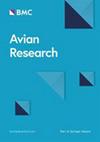Distinguishing between wild-caught and captive-bred Common Pheasant using methylation rate of skeletal muscle DNA
IF 1.7
2区 生物学
Q1 ORNITHOLOGY
引用次数: 0
Abstract
Illegal hunting and trafficking of wildlife and their derivatives extort unprecedented population decline of relatively many species pushing them towards extinction. Notwithstanding contemporary counteracting interventions at international, regional, national and local levels, wildlife farming is advocated as an alternative approach to minimize pressure on wild populations. For wildlife farming to be an effective conservation tool, the integration of wildlife forensics is inevitable to allow distinction between captive-bred and wild-caught species. To this end, we analyzed methylation rates of skeletal muscle samples (pectoralis major, triceps brachii, gastrocnemius, biceps femoris, and neck muscles) from 60 captive-bred and 30 wild-caught Common Pheasant. A total of 13,507 differentially methylated regions were identified between five wild-caught and five captive-bred individuals through whole-genome methylation sequencing (WGBS). Based on the selected five methylation sites, LOC116231076, LOC116242223, ATAD2B, EGFL6, and HS2ST, quantitative detection technique was developed using methylation-sensitive high-resolution melting curve (MS-HRM) to measure methylation rates. The results showed significant differences in methylation rates at all differential sites between wild-caught and captive-bred individuals (|t| = 0.67–33.10, P = 0.000–0.042). The discrimination accuracy rate of each locus was highest in the gastrocnemius muscle and lowest in the neck muscle. The discrimination accuracy rate on LOC116231076, LOC116242223, ATAD2B, EGFL6, and HS2ST methylation sites for gastrocnemius muscle was 64.98%, 100.00%, 68.54%, 63.79%, and 63.70%, respectively; and for neck muscle it was 67.42%, 68.06%, 83.61%, 65.04%, and 68.85%, respectively. The united discrimination accuracy rate of the five loci were 100.00% for gastrocnemius muscle, 99.78% for biceps femoris muscle, 97.52% for pectoralis major muscle, 93.96% for triceps brachii muscle, and 91.63% for neck muscle, respectively. The panel also revealed excellent repeatability, reproducibility, sensitivity and universality to mammals and avian species. This study establishes an effective, accurate and low-cost identification technology for the identification of wild and farmed Common Pheasant, and also provides a reference for the development of identification methods for other species.
利用骨骼肌DNA甲基化率区分野生和人工饲养的野鸡
非法狩猎和贩运野生动物及其衍生物,使相对许多物种的数量空前下降,使它们走向灭绝。尽管目前在国际、区域、国家和地方各级采取了对抗措施,但野生动物养殖仍被提倡作为减少野生种群压力的另一种方法。为了使野生动物养殖成为一种有效的保护工具,野生动物法医的整合是不可避免的,以区分人工繁殖和野生捕获的物种。为此,我们分析了60只人工饲养和30只野生野鸡的骨骼肌样本(胸大肌、肱三头肌、腓肠肌、股二头肌和颈部肌肉)的甲基化率。通过全基因组甲基化测序(WGBS),在5只野生和5只人工饲养个体之间共鉴定出13507个差异甲基化区域。基于所选择的5个甲基化位点LOC116231076、LOC116242223、ATAD2B、EGFL6和HS2ST,采用甲基化敏感高分辨率熔融曲线(MS-HRM)建立了甲基化率的定量检测技术。结果表明,野生捕获个体与人工饲养个体在不同位点的甲基化率差异显著(|t| = 0.67 ~ 33.10, P = 0.000 ~ 0.042)。各位点的识别准确率以腓肠肌最高,颈肌最低。对腓肠肌LOC116231076、LOC116242223、ATAD2B、EGFL6和HS2ST甲基化位点的识别准确率分别为64.98%、100.00%、68.54%、63.79%和63.70%;颈部肌肉分别为67.42%、68.06%、83.61%、65.04%和68.85%。5个基因座对腓肠肌、股二头肌、胸大肌、肱三头肌、颈肌的联合识别准确率分别为100.00%、99.78%、97.52%、93.96%和91.63%。该小组还显示了对哺乳动物和鸟类物种的出色重复性、再现性、敏感性和普遍性。本研究为野生和养殖野鸡的鉴定建立了一种有效、准确、低成本的鉴定技术,也为其他物种鉴定方法的开发提供了参考。
本文章由计算机程序翻译,如有差异,请以英文原文为准。
求助全文
约1分钟内获得全文
求助全文
来源期刊

Avian Research
ORNITHOLOGY-
CiteScore
2.90
自引率
16.70%
发文量
456
审稿时长
46 days
期刊介绍:
Avian Research is an open access, peer-reviewed journal publishing high quality research and review articles on all aspects of ornithology from all over the world. It aims to report the latest and most significant progress in ornithology and to encourage exchange of ideas among international ornithologists. As an open access journal, Avian Research provides a unique opportunity to publish high quality contents that will be internationally accessible to any reader at no cost.
 求助内容:
求助内容: 应助结果提醒方式:
应助结果提醒方式:


